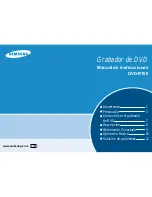
T: +1-613-545-0466 F: +1-613-542-8029 www.mrel.com
31
8. The
PROBEROD
installation aspects of the test are complete. The Operator can now place the detonator and connect it to the shot
exploder as per standard procedures. The
DataTrap II™
Data/VOD Recorder
is now ready to be prepared to record the test.
5.4 Installing ProbeCable For Testing Explosives In Blastholes
The equipment and supplies that are required to conduct
VOD
tests on samples of explosives in blastholes are:
1. The
DataTrap II™
Data/VOD Recorder
System with
VOD Upgrade
installed.
2.
VOD PROBECABLE
“
GREEN
” or
VOD PROBECABLE-LR
“
BLUE
” (available from
MREL
).
3. Coaxial cable (type RG-58 is recommended) - sufficient length to run between the
DataTrap II™
Data/VOD Recorder
location and
the last blasthole in the blast to be recorded.
4. Wire cutters and electrical tape.
5. Explosives, detonators and shot exploder.
5.4.1 Preparation Of ProbeCable For Single Blasthole Recording
1. Prepare the end of the
PROBECABLE
by using the wire cutters to remove the insulation from the end. Then short the
PROBECABLE
by
connecting the shielding wire to the center conductor wire and twist them together. Protect the connection well with electrical tape.
2. Using tape or wire, attach the short circuit end of the
PROBECABLE
to the primer/booster or to a rock and lower the
PROBECABLE
into the hole as shown in the diagram to the right. Detonation cord downlines may damage the
PROBECABLE
or cause side initiation
of the bulk explosive. When initiating with detonation cord, attach the
PROBECABLE
to a rock and lower it on the side of the hole
opposite to the detonation cord downline.
3. The
PROBECABLE
can then be cut at the top of the hole.
4. Note the Unit Resistance of the probe by reading the value in ohm/m or ohm/ft from the
MREL
factory label on the spool of
PROBECABLE
. Note the ohm/m value if the
VOD
is to be reported in m/s. Note the ohm/ft value if the VOD is to be reported in ft/
sec. The Unit Resistance information will be requested later by the
DAS™ Data Acquisition Suite
. When measured with a blaster’s
galvanometer, the Probe Resistance should compare favorably with the calculated resistance of the
PROBECABLE
(Unit Resistance
multiplied by length). If this is not the case then remove the length of
PROBECABLE
and reload another length into the hole.
5. The hole can now be loaded with explosives and stemming per usual procedure. Hold the
PROBECABLE
taut during the loading of
the explosive to avoid slack in the hole. If you will not be present during loading, tie the
PROBECABLE
taut around a hole marker
stake, or around a rock at the top of the borehole. After loading, you may wish to check the total resistance of the
PROBECABLE
to
ensure that no damage has occurred. Damage is unlikely, as the
PROBECABLE
is well protected with PVC coating.
6. Connect the
PROBECABLE
to the coaxial cable using the wire cutters and electrical tape. The connection should be “shielding to
shielding” and “center to center”. Ensure that the center conductor and the shielding connections do not touch each other.
7. Place the
DataTrap II™
Data/VOD Recorder
in a protective shelter (a short piece of steel pipe is a good shelter) and/or a safe
distance away from the blast area as dictated by flyrock. This distance may be closer than what is considered safe for the User.
When set, the
DataTrap II™
Data/VOD Recorder
does not require a User to collect the data; the
DataTrap II™
Data/VOD Recorder
records the data automatically.
8. Run the coaxial cable from the
PROBECABLE
to the
DataTrap II™
Data/VOD Recorder
. Shorter lengths of coaxial cable may be
connected together using the wire cutters and electrical tape. Somewhere along the length of the coaxial cable, loop the coaxial
cable around a large rock. When the blast is fired, and the ground moves, looping the coaxial cable around a large rock will stop
the blast from pulling the coaxial cable, and the
DataTrap II™
Data/VOD Recorder
, with the blast. Alternatively, leave sufficient slack
in the coaxial cable to allow for ground movement.
9. A male BNC connector should be attached to the end of the coaxial cable that is to be attached to the channel inputs
(labeled
1 2 3 4 5 6 7 8
) on the back of the
DataTrap II™
Data/VOD Recorder
. Convenient
BNC Adapters
have been supplied with
the
DataTrap II™
Data/VOD Recorder
for this purpose. The BNC Adapters should be connected to the coaxial cable using the wire
cutters and electrical tape. The connection should be shielding to shielding and center conductor to center conductor. Ensure that the
Summary of Contents for DATA TRAP II
Page 5: ...T 1 613 545 0466 F 1 613 542 8029 www mrel com 1 Chapter 1 Getting Started...
Page 7: ...T 1 613 545 0466 F 1 613 542 8029 www mrel com 3 Chapter 2 Introduction...
Page 11: ...T 1 613 545 0466 F 1 613 542 8029 www mrel com 7 Chapter 3 Hardware...
Page 25: ...T 1 613 545 0466 F 1 613 542 8029 www mrel com 21 Chapter 4 Memory And Triggering...
Page 28: ...DataTrap II Operations Manual Edition 5 4 24...
Page 29: ...T 1 613 545 0466 F 1 613 542 8029 www mrel com 25...
Page 30: ...DataTrap II Operations Manual Edition 5 4 26...
Page 50: ...DataTrap II Operations Manual Edition 5 4 46...
Page 51: ...T 1 613 545 0466 F 1 613 542 8029 www mrel com 47 Chapter 7 Strain Gauge Upgrade...
Page 59: ...T 1 613 545 0466 F 1 613 542 8029 www mrel com 55...
















































